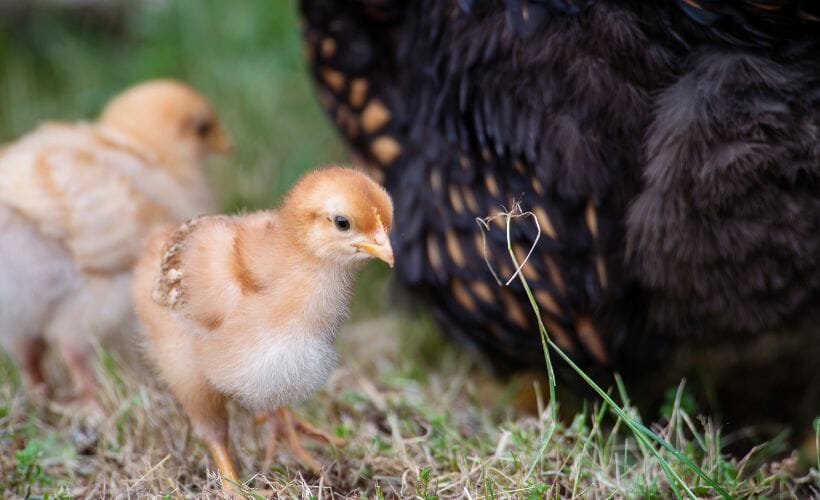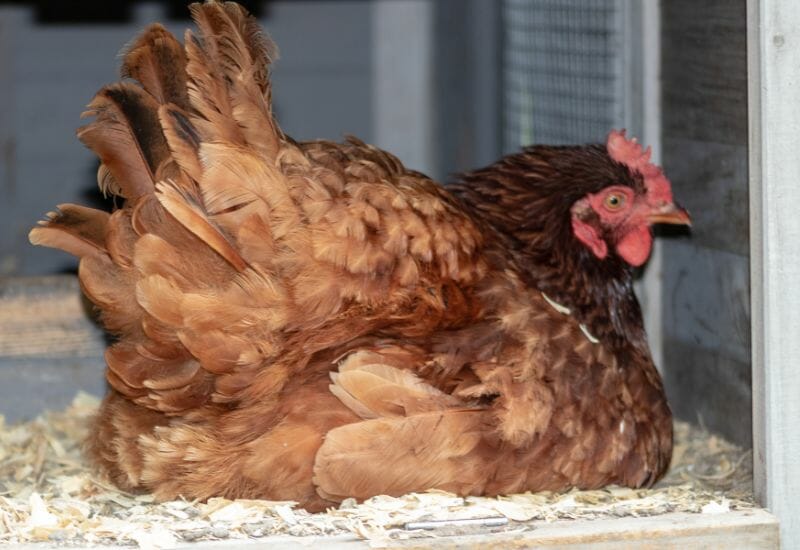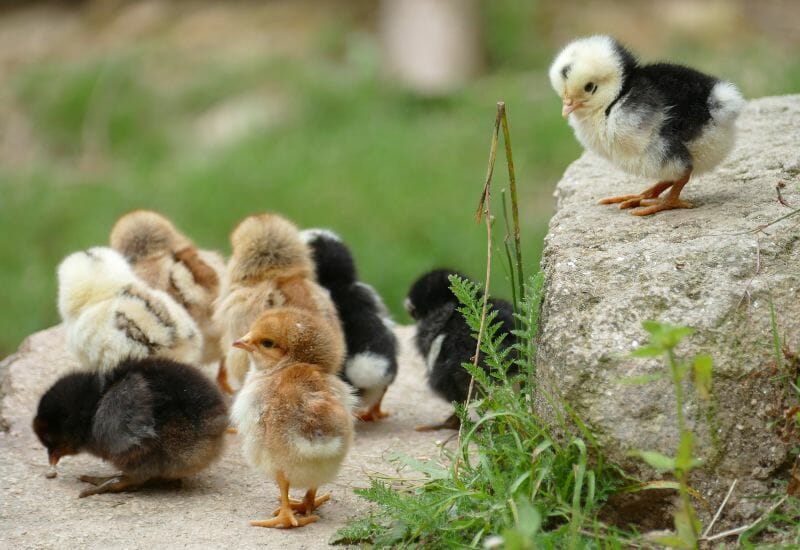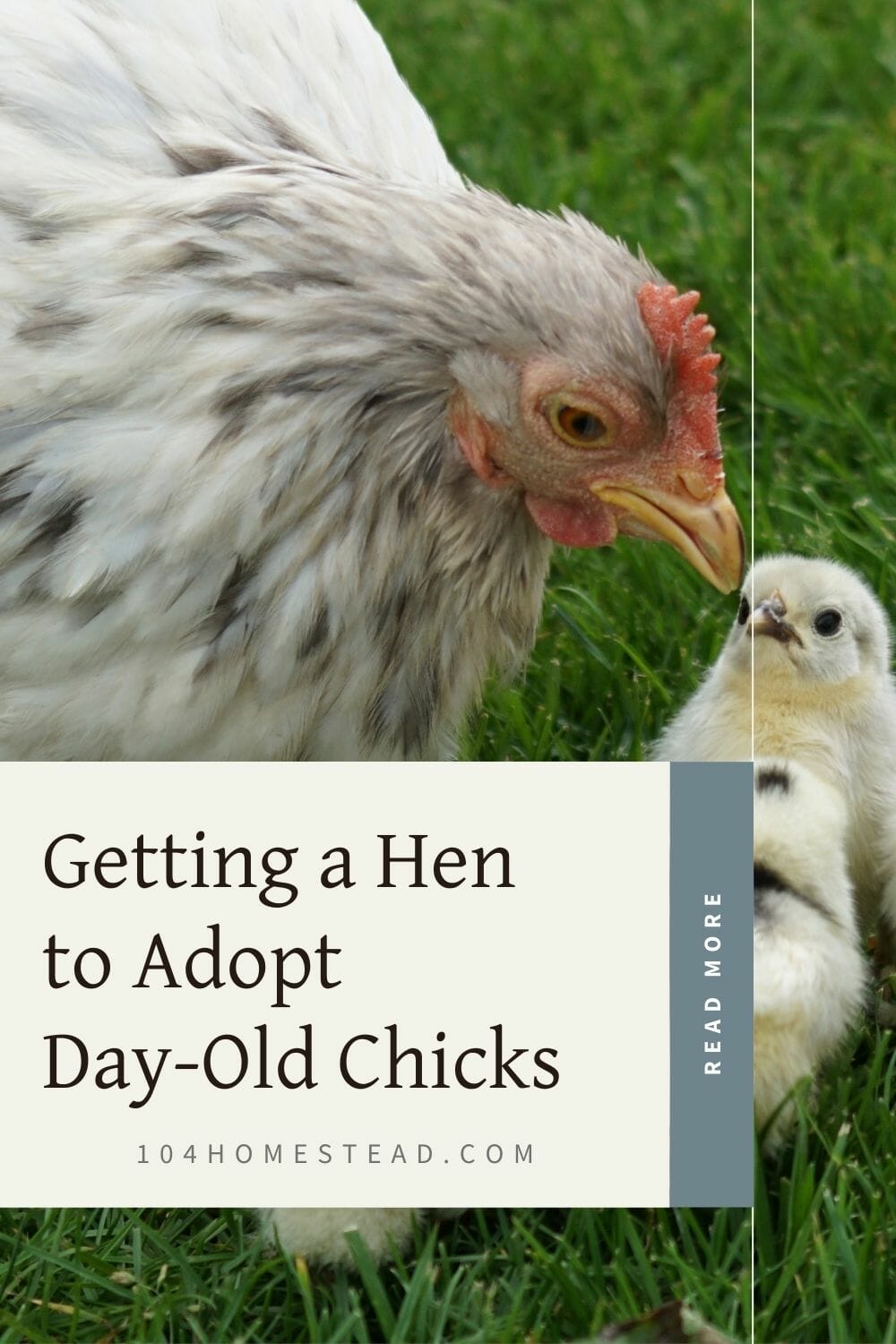How to Introduce Chicks to a Broody Hen Seamlessly
Don’t want to hatch from your own eggs? You can still use a hen as an adoptive mother. Learn how to introduce chicks to a broody hen.

Are you a backyard chicken keeper looking to expand your flock? Or perhaps you’re a novice poultry enthusiast eager to witness the miracle of motherhood in action? Introducing day-old chicks to a broody hen can be as intimidating as exciting. Chick adoption can be rough, but fear not!
From preparing the broody hen to monitoring their interactions, I’ll guide you through each step of the process. So, prepare to embark on a journey that guarantees the well-being of your chickens and the formation of a harmonious flock. Let’s dive in!
Why You Might Have a Broody Hen Adopt Your Chicks
One of the benefits of having a hen brood your chicks is that it saves you time and effort. You don’t have to worry about a heat source, cleaning out a stinky brooder, or integrating chicks into an established flock later. The mother hen will protect the chicks from dangers like predators by hiding them under her wings or placing them in a safe spot under the coop. In addition to protection, she will naturally teach them how to behave like chickens, scratch for food, eat, drink, and socialize.
If your hen hatches her own chicks, this process will happen naturally. But maybe you want to purchase a new breed of chicks, and you don’t want to brood them indoors. Or, possibly, you have a hen that hatched more chicks than she can handle, and you want to split them between her and a broody hen you have on hand? That’s why knowing how to introduce chicks to a broody hen is important.
The Steps to Day-Old Chick Adoption
There are four steps to integrating baby chicks with a hen. Although I have a nearly perfect track record at getting hens to accept the chicks I give them, it’s wise to have a brooder setup in case she doesn’t accept them.
Preparing the Broody Hen
To ensure a successful introduction between chicks and a broody hen, it is essential to properly prepare the broody hen for her new role as a surrogate mother. Taking the time to prepare her will help create a safe and nurturing environment for the chicks, minimizing the chances of any clashes or aggression.
First and foremost, it’s important to ensure that the broody hen is physically and mentally ready to care for the chicks. Make sure she is in good health, with no underlying health issues that could hinder her ability to care for the young ones. Ensure the hens are broody, having sat reliably on eggs for at least a few weeks. Most hens will have no interest in raising chicks unless they are already broody.
Signs of a Broody Hen
There are a few things you can look for to determine if your hen is broody.
- The hen will often peck at your hand when you check for eggs.
- The chest and belly feathers are missing.
- The hen’s comb and wattles are pale.
- The broody only leaves the nest once or twice a day for only a short period of time.
- The hen is very flattened out on the nest.
Next, provide the broody hen with a suitable nesting area that is comfortable and secure. This could be a separate area within the chicken coop or even a dedicated broody box. Use soft, clean bedding materials such as straw or hay to create a cozy nest, and ensure that the area is well-ventilated to maintain a comfortable temperature.
To encourage the broody hen to accept the chicks as her own, you must give her some time sitting on eggs. These can be eggs from your flock or dummy eggs made of ceramic or wood.
Lastly, observe the broody hen’s behavior closely during the preparation phase. Look for signs of aggression or excessive protective behavior, which could indicate that the broody hen is not ready for the introduction. If any concerns arise, it may be necessary to delay the introduction until the broody hen is better prepared.

Create a Safe Environment
In addition to preparing the broody hen for introducing the day-old chicks, creating a safe environment for both the hen and the chicks is crucial. The goal is to ensure a stress-free space that promotes a smooth transition and fosters a sense of security for all parties involved.
Ensure the broody hen’s nesting box is clean, comfortable, and spacious enough to accommodate the hen and her chicks. Choose a quiet and secluded spot away from high foot traffic or other animals that might disrupt the broody hen or intimidate the chicks. Providing a peaceful environment gives the hen and her chicks the best chance for a smooth integration and bonding experience.
Introduce the Chicks
A broody hen who has been properly prepared is more likely to embrace her new role as a mother and provide a nurturing environment for the chicks to thrive. With a safe environment, it’s time to introduce the chicks and witness the magic as the broody hen’s maternal instincts take over. Remember that each hen may react differently to the young chicks, so monitoring the situation closely is important.
Your newly-hatched chicks don’t necessarily need to be a day old, but they should be less than a week in age. The younger, the better.
During the introduction, it’s normal for the broody hen to initially show some level of curiosity or apprehension towards the chicks. She may bob her head, cluck softly, or puff up her feathers. Allow the broody hen to approach the chicks at her own pace, observing her body language for signs of distress or aggression.
As the chicks are placed within the hen’s reach, continue to monitor her behavior closely. Ideally, the broody hen will start exhibiting signs of acceptance, such as allowing the chicks to gather around her or hunkering down to keep them warm. These interactions signify the beginning of the bond between the broody hen and the chicks.
With the introduction complete, it’s time to proceed to the next phase: monitoring and bonding, where you will continue to observe the relationship between the broody hen and her newfound chicks.
Monitoring & Bonding
While it is natural for the broody hen to be protective and assertive, you should also be mindful of aggressive behaviors. If the broody hen shows signs of aggression towards the chicks, such as pecking them forcefully or trying to drive them away, you may need to intervene to prevent any harm. This could involve temporarily separating the chicks from the broody hen or providing a barrier that allows visual contact but prevents physical contact until the broody hen calms down.

The Dos & Don’ts for a Smooth Integration
Since you have successfully introduced the day-old chicks to the broody hen, ensuring a smooth integration between them is important. To help you navigate this process, here are some dos and don’ts to keep in mind:
- DO give them space and time: After the initial introduction, giving the broody hen and the chicks some space to bond naturally is best. Avoid disturbing them unnecessarily and allow them to establish their unique dynamic. This will help build trust and minimize stress.
- DO provide ample resources: Make sure plenty of food and water sources are available for the broody hen and the chicks. Ensuring everyone has access to nourishment is essential, especially during this critical integration period.
- DO monitor their interactions: While giving them space is important, monitoring their interactions is equally crucial. Observe how the broody hen responds to the chicks and how the chicks behave around her. Look for signs of aggression or distress and be prepared to intervene if necessary.
- DON’T introduce additional flock members too soon: It’s best to wait until the broody hen and the chicks have successfully integrated before introducing any additional flock members. This will allow the bond between the broody hen and her chicks to solidify and reduce the likelihood of conflicts.
- DON’T rush the process: Integration takes time, so avoid rushing the process. Each broody hen and her chicks have a unique timeline for bonding. Be patient and allow them to develop their relationship at their own pace. Remember, a smooth integration is worth the wait.
By following these dos and don’ts, you’ll be well-equipped to nurture the bond between the mama hen and her chicks and ensure a harmonious integration for your feathered family.
Chick & Hen Adoption FAQs
Here are answers to many common questions regarding day-old chick and hen integrations.
With these guidelines, you can navigate this delicate process successfully, leading to harmonious coexistence between the broody hen and the chicks. By providing them with a safe and comfortable environment, attentively monitoring their interactions, and following the best practices, you’ll soon witness a thriving and contented flock. Happy chickening!
If you’ve found value in this blog post and enjoyed reading it, why not share it with your Pinterest community? Pin the image below and spread the love!


